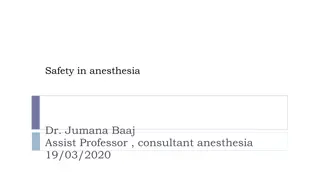Understanding Fluid Bolus in Anesthesia Management
Anesthesia providers often face challenges like hypotension during procedures. In such cases, increasing fluids can help expand blood volume temporarily. However, it is crucial to calculate the amount of fluid accurately to prevent complications like albumin washout, which can lead to further issues. Different types of isotonic fluids can be used for bolus administration, considering the osmotic gradient to maintain vascular integrity.
Download Presentation

Please find below an Image/Link to download the presentation.
The content on the website is provided AS IS for your information and personal use only. It may not be sold, licensed, or shared on other websites without obtaining consent from the author. Download presentation by click this link. If you encounter any issues during the download, it is possible that the publisher has removed the file from their server.
E N D
Presentation Transcript
Monitoring Any Anesthesia Patient Ken Crump, AAS, AHT 1
Monitoring any anesthesia patient Anesthetist's lament: "Heaven forbid the patient may have more than one problem" We tend to focus on the problem we are most concerned with, and forget the common complications that occur during anesthesia. We still have a lot of balls in the air. Like hypotension. 2
What Do You Do For Hypotension? 1.- 2.- 3.- 3
What Do You Do For Hypotension? Answers: 1. - Increase fluids 2. - Decrease gas 3. - Cross fingers 4
Increase Fluids Why? Expand blood volume Temporary fix while you solve the problem How? Drip? (slow) Bolus? (fast) 5
Increase Fluids How much fluid? Drip You re already expanding blood volume by giving IV fluids during anesthesia How s that working for you? Bolus More effective Calculate using body weight (with a glance at the TP) 6
Fluid Bolus What type of fluid? Isotonic fluid Ringers LRS Normosol Saline They contain nothing to maintain the osmotic gradient 7
Osmotic Gradient Vessels are leaky. Something has to hold fluid inside the vascular space or it would leak out. Albumin ~ of Total Protein 3 4 g/dL albumin is normal ~1.5 g/dL albumin required to maintain the osmotic gradient 8
What does this have to do with a fluid bolus? 9
Fluid Bolus If you put too much fluid into the blood vessels, you can wash out the albumin and the fluid will leak out of the blood vessels. That can cause more problems than it solves. That s why it s necessary to calculate the amount of fluid to give as a bolus. 10
Using A Fluid Bolus for Hypotension The short answer: 1. Increase fluids to expand blood volume 2. It s a temporary fix while you solve the real problem 3. A fluid bolus is more effective than increasing the drip rate The fluid bolus: 1. Too much fluid is too much fluid 2. Give a bolus of 5mL/kg by rapid infusion 3. Repeat if necessary as many as 4 times 4. If what you re trying isn t working, try something else. 11
Fun for Math Geeks Do a PCV / TP before and after anesthesia on patients who have received fluids during anesthesia. You can use the change in PCV / TP to guess- timate the amount of fluids the patient received. Hint: You ll need to know the patient s blood volume Dogs = 90 mL/kg Cats = 60 mL/kg 12
Post Op / Recovery It ain't over till it's over! Again, emergence from general anesthesia is best when it's gradual. Do NOT reverse drugs to hasten extubation. This patient's primary anesthetic challenge was a potential pneumothorax. The potential is still there in recovery. Consider monitoring ETCO2 for as long as the patient is intubated 13
Post Op / Recovery We are all watching the clock and trying to get to our next case. And you can't leave your patient until it's extubated. But a comfortable emergence from general anesthesia is the beginning of a smooth recovery. 14

















































